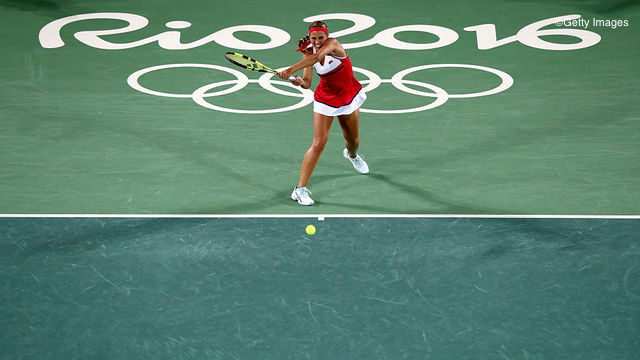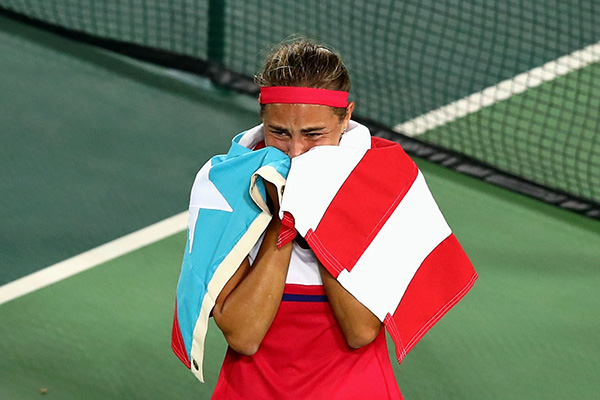THE WINNERS
Monica Puig made Olympic history for Puerto Rico on Saturday night, becoming the island’s first ever gold medalist after a rollercoaster win over World No.2 Angelique Kerber, 6-4, 4-6, 6-1.
Puig has been the surprise of the Olympic tennis event, playing the best tennis of her career to reach the gold medal match and dealing out upsets to the likes of French Open champion Garbiñe Muguruza and two-time Wimbledon champion Petra Kvitova along the way.
She now stands as the first athlete – male or female – to bring home a gold medal to Puerto Rico, ending a 68-year drought dating back to the island’s first appearance at an Olympic Games.
“This is for Puerto Rico. This is definitely for them,” Puig said. “They’re going through some tough times right now, and they needed this. I needed this.
“I think I united a nation. I just love where I come from.”
Read the full match recap | WTA Insider Live Blog: Game-by-game analysis
Four years after pairing up for the first time ahead of the Olympic tennis event in London, No.7 seeds Ekaterina Makarova and Elena Vesnina strike gold in Rio, taking out No.5 seeds and World Co-No.1 Martina Hingis and countrywoman Timea Bacsinszky, 6-4, 6-4.
“It’s incredible,” Vesnina said after the match. “Ever since I was a little girl, I was watching the Olympic Games, and it was such a dream just to come here and get a medal for Russia, for my country and in front of my dad. We’ve been through so much, and yet we were so good today.
“We stuck together and we believed til the end that we could win. It’s just incredible, I still can’t believe that we won the gold. It’s the best moment in my career, I swear!”
Makarova and Vesnina came to Rio having just won their first title of the season at the Rogers Cup, but not before enduring a nightmarish travel itinery that nearly left them late for the Opening Ceremonies. Once there, the Russian duo took care of business in efficient style, running through five wins without dropping a set over the opposition.
Read the full match recap here.
In a thrilling encounter between two tough American teams, Bethanie Mattek-Sands partnered Jack Sock to take out four-time gold medalist Venus Williams and Rajeev Ram, 6-7(3), 6-1, 10-7 and win gold in mixed doubles of the Olympic tennis event.
“I’m still pretty emotional,” Mattek-Sands said after the match. “I think, going into this final, we knew the American national anthem was going to be played either way, but I was actually kind of surprised I was so emotional. It’s my first Olympics, first time being up on the podium. It’s hard to describe it in words, but I’m so excited having this guy next to me, we played awesome. It was a lot of fun this whole week.”
Read the full match recap here.
RANKING MOVERS
There were no WTA ranking points awarded at the Olympic tennis event for the week of August 15, 2016.
Click here to view the current rankings.
UPCOMING TOURNAMENTS
Western & Southern Open
Cincinnati, USA
Premier | $2,503,250 | Hard, Outdoor
Monday, August 15 – Sunday, August 21
Connecticut Open
New Haven, USA
Premier | $695,900 | Hard, Outdoor
Sunday, August 21 – Saturday, August 27
US Open
New York, USA
Grand Slam | $ TBA | Hard, Outdoor
Monday, August 29 – Sunday, September 11
TOP 20 PLAYER SCHEDULES
1. Serena Williams – Cincinnati, US Open
2. Angelique Kerber – Cincinnati, US Open
3. Garbiñe Muguruza – Cincinnati, US Open
4. Simona Halep – Cincinnati, US Open
5. Agnieszka Radwanska – Cincinnati, US Open
6. Venus Williams – US Open
7. Victoria Azarenka
8. Roberta Vinci – Cincinnati, New Haven, US Open
9. Madison Keys – New Haven, US Open
10. Svetlana Kuznetsova – Cincinnati, New Haven, US Open
11. Dominika Cibulkova – Cincinnati, New Haven, US Open
12. Carla Suárez Navarro – Cincinnati, US Open
13. Johanna Konta – Cincinnati, New Haven, US Open
14. Petra Kvitova – New Haven, US Open
15. Timea Bacsinszky – Cincinnati, New Haven, US Open
16. Samantha Stosur – Cincinnati, US Open
17. Karolina Pliskova – Cincinnati, New Haven, US Open
18. Anastasia Pavlyuchenkova – Cincinnati, New Haven, US Open
19. Elina Svitolina – Cincinnati, New Haven, US Open
20. Barbora Strycova – Cincinnati, New Haven, US Open
HAPPY BIRTHDAY TO YOU!
Best wishes to those celebrating birthdays this week:
Chan Yung-Jan (TPE) – August 17, 1989
Johanna Larsson (SWE) – August 17, 1988
















